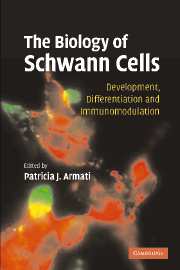Book contents
- Frontmatter
- Contents
- Preface
- Contributors
- 1 Introduction to the Schwann cell
- 2 Early events in Schwann cell development
- 3 The molecular organisation of myelinating Schwann cells
- 4 The role of the extracellular matrix in Schwann cell development and myelination
- 5 The biology of perisynaptic (terminal) Schwann cells
- 6 Cytokine and chemokine interactions with Schwann cells: the neuroimmunology of Schwann cells
- 7 Schwann cells as immunomodulatory cells
- 8 Mutations in Schwann cell genes causing inherited neuropathies
- 9 Guillain–Barré syndrome and the Schwann cell
- 10 Chronic idiopathic demyelinating polyneuropathy and Schwann cells
- References
- Index
- Plate section
4 - The role of the extracellular matrix in Schwann cell development and myelination
Published online by Cambridge University Press: 13 August 2009
- Frontmatter
- Contents
- Preface
- Contributors
- 1 Introduction to the Schwann cell
- 2 Early events in Schwann cell development
- 3 The molecular organisation of myelinating Schwann cells
- 4 The role of the extracellular matrix in Schwann cell development and myelination
- 5 The biology of perisynaptic (terminal) Schwann cells
- 6 Cytokine and chemokine interactions with Schwann cells: the neuroimmunology of Schwann cells
- 7 Schwann cells as immunomodulatory cells
- 8 Mutations in Schwann cell genes causing inherited neuropathies
- 9 Guillain–Barré syndrome and the Schwann cell
- 10 Chronic idiopathic demyelinating polyneuropathy and Schwann cells
- References
- Index
- Plate section
Summary
INTRODUCTION
The cellular components of the peripheral nervous system (PNS) – neurons and their axons, Schwann cells, perineurial cells, endoneurial fibroblasts and vessel endothelia – are surrounded by extracellular components such as collagens, fibronectin, laminins and proteoglycans. These components are either part of extracellular matrix or organised in the basal lamina. These molecules are recognised by cellular receptors on Schwann cells, such as integrins and dystroglycan. Engagement of matrix components by cognate receptors modulates nearly all aspects of Schwann cell development including: proliferation, survival, migration, interaction with axons, differentiation, myelination, and formation of the nodes of Ranvier. After a general review of the extracellular matrix molecules and their known functions in peripheral nerve, we will focus on the role of laminins in Schwann cell differentiation, Schwann cell/axon interactions, organisation of the axonal membrane and myelination.
EXTRACELLULAR MATRIX IN ENDONEURIUM
Every nerve is characterised by: the epineurium, surrounding the whole nerve; the perineurium, surrounding fascicles of nerve fibres; and the endoeurium, defined as the area contained within the perineurium, and in which the single fibres are contained. The adult endoneurium contains abundant amounts of extracellular matrix, which can be present in extracellular spaces among nerve fibres, associated with fibroblasts and organised in basal laminae around Schwann cells or endothelia; or anchored or spanning cell membranes in Schwann cells, endothelia or fibroblasts. The non-cell-associated matrix is mainly composed of fibrillary collagen, while most of the other extracellular matrix components are associated with fibroblasts (Joseph et al. 2004).
- Type
- Chapter
- Information
- The Biology of Schwann CellsDevelopment, Differentiation and Immunomodulation, pp. 55 - 71Publisher: Cambridge University PressPrint publication year: 2007



